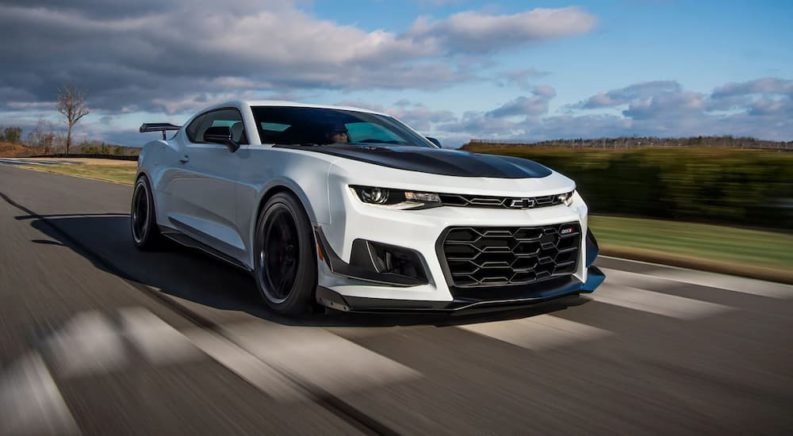What do a pair of Catholic priests, a demonic spirit, and a Chevy dealer have in common? It’s all in the name. The Exorcist is a staple among film fans as the 1973 horror flick tells the tale of a mother who seeks the help of Catholic priests to rid her daughter of demonic possession. In the Chevy realm, The Exorcist is the heavy-hitting Chevy Camaro ZL1 with a Hennessy twist. It’s Chevy’s answer to the Dodge Challenger SRT Demon, proving that Chevy is more than capable of producing a muscle car that can drop any rival to its knees.
Recently, Hennessey Performance Engineering celebrated its 30th anniversary in grand style by introducing a limited production run of the 30th Anniversary Exorcist Camaro ZL1. But what inspired The Exorcist in the first place, and how has it impacted the muscle car realm? It lives up to its name, exorcising the demons of speed and leaving every driver begging for another lap around the track.
Competition Breeds Innovation
The automotive industry is fiercely competitive, and while this may seem cutthroat to most, it’s a breeding ground for innovation. As a result, automakers are constantly working to outdo one another, repositioning themselves in the lead with new models that are bigger, better, and more capable. It’s why Ford, Chevrolet, and Chrysler have spent decades vying for the top spot as America’s leading automaker, and it’s why sports cars like the Mustang, Camaro, and Challenger continue to get better with time.
The Demon
Industry competition was at an all-time high when Dodge not so coyly announced an all-new Challenger known as the Demon. The Mopar muscle car made its official debut as the 2018 Challenger SRT Demon, the industry’s first and only purpose-built, street-legal production drag car. So, did it live up to Dodge’s promise to impress?
The Demon proved mightier than its Hellcat sibling right from the starting line. In an unabashed attempt to steal the spotlight, Dodge pulled out all the stops with the Demon and outfitted it with a supercharged 6.2L HEMI V8 engine. Filling the tank with 100-plus-octane race fuel pushes the HEMI to 840 hp, a launch from 0 to 60 mph in 2.3 seconds, and a quarter-mile run of 9.65 seconds at 140 mph. It’s safe to say the Demon lived up to the hype.
As the first production car to complete a front wheelie, the Demon earned a place in the Guinness World Records and forever stole the hearts of muscle car fans with a penchant for speed and deep pockets. It’s $84,995 starting MSRP included a full day at the Bob Bondurant School of High-Performance driving and the option to add a race-ready package for $1. The Demon Crate package equipped the muscle car with everything needed to get its HEMI to 840 hp, including a performance powertrain control module calibrated for high-octane fuel, a replacement switch module with the high-octane button, a conical performance air filter, hydraulic floor jack, and a cordless impact wrench with charger among other parts. Dodge also added several other packages, including the Demon Street Tire Package and the Rear-Seat Delete Package through Mopar.
The Exorcist
Dodge’s frequent teasers of the Demon piqued widespread interest, catching the attention of the legendary Hennessey Performance Engineering. Loving a good chance to compete, Hennessey knew it could beat Mopar’s muscle car and turned to the Chevrolet Camaro ZL1 for its base. With the supercharged Camaro already churning out 650 hp and 650 lb-ft of torque, Hennessey had one hell of a foundation to build a muscle car that could match the Demon.
Hennessey took the Camaro ZL1 and added a higher flowing supercharger and intercooler system to produce 14 psi of boost pressure. By upgrading the camshaft, adding long-tube stainless steel headers, ported factory cylinder heads, custom engine management calibration, and a high-flow air induction system, Hennessey pushed the Camaro ZL1’s stock 650 hp to 1,000 hp and 883 lb-ft of torque. It exorcised the demon right off the track.
In addition to this jaw-dropping power, Hennessey also offered optional drag and road race packages. The drag pack added a pair of 20-inch Nitto drag radial tires to the Camaro, an upgraded driveshaft, a tool kit, and a floor jack. The road race pack swapped the Nitto tires for 20-inch lightweight Hennessey wheels with Michelin Pilot Sport Cup 2 tires and an upgraded transmission with models equipped with the 10-speed automatic.
While Dodge’s limited production run of the Demon spanned only 3,300 models, Hennessey took another cue from Mopar and made The Exorcist far more exclusive. On top of the Camaro ZL1’s base price of $62,135, Hennessy’s upgrades added $55,000 to the sticker price, not including the drag pack or road race pack. With only 100 models produced each year, Hennessey cornered the market on exclusivity, making the Exorcist all the more enticing.
The Exorcist Rises Again
To celebrate its 30 years in business, the Texas-based Hennessey Performance Engineering unveiled the 30th-anniversary edition of The Exorcist Camaro ZL1 in 2021. Still committed to a 100-unit production run, Hennessey left 30 slots open for the special edition with its unique exterior badging and exclusive build plaque under the hood. For Hennessey, the celebratory model seemed fitting from a company that’s been making fast cars faster since the early 1990s.
“The Exorcist is the epitome of the American muscle car and has the off-the-line performance to embarrass almost any car on the planet,” CEO John Hennessey announced. “Our 30th Anniversary Exorcist pools all we know into one ferocious supercar slayer.”
Like its predecessors, the 30th-anniversary edition of The Exorcist takes the Camaro ZL1’s supercharged 6.2L V8 and pushes it to deliver 1,000 hp. This heart-stopping power translates to a top speed of 217 mph and takes The Exorcist from 0 to 60 mph in 2.1 seconds with a 9.57-second quarter mile at 147 mph, leaving the Demon in the dust once again.
The Need for Speed: The Fuel of the Automotive Industry
The fierce competition among automakers is mutually beneficial every way you look at it. This competition breeds innovation, challenging performance-oriented companies like Hennessey and automakers like Dodge and Chevrolet to raise the bar and set new standards of performance and capability. In turn, drivers reap the benefits of this competition each time they get behind the wheel of a powerhouse like The Exorcist or the Demon; we’re the ones buying these models and giving feedback. We’re the ones on the front lines telling automakers what we like and don’t like, sending them back to the drawing board time and time again.
This constant cycle has been a staple in the automotive industry since the early 1900s. If you think about it, the need for speed is something we’ve always yearned for. The horse-drawn carriage was acceptable, but automotive pioneers like Ford knew there had to be a more efficient way. The Model T introduced drivers to a new means of transportation that was faster and could make their lives easier. Thus, the trusty steed was replaced with the speedier automobile.
The need for speed has continued ever since. We’re desperate to go faster so that we can see and experience more. We like the thrill of seeing the needle climb on the speedometer just as much as we appreciate a responsive steering wheel or hearing our heartbeat in our ears as adrenaline takes over. This need for speed is the basis for competition in the automotive industry, and it’s the foundation of rivalries like what we’ve seen between the Demon and The Exorcist. It just so happens that, in this case, The Exorcist lives up to its name and uses its power to its advantage, leaving the Demon in the dust, Catholic priests, holy water, and Hail Marys not required.




